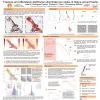Poster #149, Fault and Rupture Mechanics (FARM)
Nucleation of earthquake slip on heterogeneous interfaces
Poster Image:

Poster Presentation
2020 SCEC Annual Meeting, Poster #149, SCEC Contribution #10736 VIEW PDF
f slip on a 2D frictional interface embedded in a homogeneous elastic space, with an efficient and rigorous numerical procedure for elastodynamic analysis of sequences of aseismic slip and dynamic ruptures on slowly loaded interfaces. Using the diverse spectrum of nucleation behaviors observed in these models, our work is directed towards understanding several questions fundamental to earthquake science. Do small and large earthquakes initiate similarly? Are large earthquakes just small earthquakes that ran away? What model features result in foreshock-like events, i.e. smaller events that occur during the nucleation of larger events? How does the simulated critical length scales for instability, averaged over several events, compare with the nucleation size estimate for uniform interfaces?
We find that earthquakes can initiate from scales much smaller than the nucleation size estimates calculated for uniform interfaces with equivalent average properties. As the heterogeneities become stronger, small-scale events appear, complicating the nucleation process. We observe a continuum of behaviors ranging from purely fault-spanning events to persistent foreshock-like events interspersed between mainshock cycles. We also find more variation in the final sizes of events in these heterogeneous conditions. Overall, we aim to understand how local heterogeneities in friction properties translate into large-scale behaviors, both in terms of stability and slip patterns.
SHOW MORE
We find that earthquakes can initiate from scales much smaller than the nucleation size estimates calculated for uniform interfaces with equivalent average properties. As the heterogeneities become stronger, small-scale events appear, complicating the nucleation process. We observe a continuum of behaviors ranging from purely fault-spanning events to persistent foreshock-like events interspersed between mainshock cycles. We also find more variation in the final sizes of events in these heterogeneous conditions. Overall, we aim to understand how local heterogeneities in friction properties translate into large-scale behaviors, both in terms of stability and slip patterns.
SHOW MORE
























































